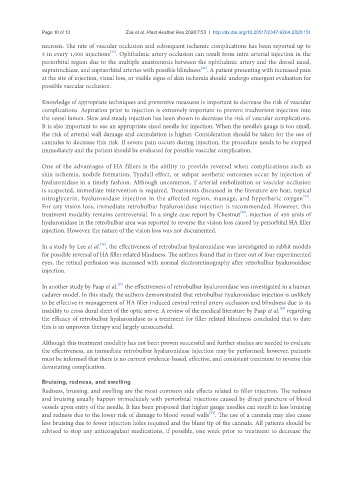Page 618 - Read Online
P. 618
Page 10 of 13 Ziai et al. Plast Aesthet Res 2020;7:53 I http://dx.doi.org/10.20517/2347-9264.2020.151
necrosis. The rate of vascular occlusion and subsequent ischemic complications has been reported up to
[23]
3 in every 1,000 injections . Ophthalmic artery occlusion can result from intra-arterial injection in the
periorbital region due to the multiple anastomosis between the ophthalmic artery and the dorsal nasal,
[24]
supratrochlear, and supraorbital arteries with possible blindness . A patient presenting with increased pain
at the site of injection, visual loss, or visible signs of skin ischemia should undergo emergent evaluation for
possible vascular occlusion.
Knowledge of appropriate techniques and preventive measures is important to decrease the risk of vascular
complications. Aspiration prior to injection is extremely important to prevent inadvertent injection into
the vessel lumen. Slow and steady injection has been shown to decrease the risk of vascular complications.
It is also important to use an appropriate sized needle for injection. When the needle’s gauge is too small,
the risk of arterial wall damage and cannulation is higher. Consideration should be taken for the use of
cannulas to decrease this risk. If severe pain occurs during injection, the procedure needs to be stopped
immediately and the patient should be evaluated for possible vascular complication.
One of the advantages of HA fillers is the ability to provide reversal when complications such as
skin ischemia, nodule formation, Tyndall effect, or subpar aesthetic outcomes occur by injection of
hyaluronidase in a timely fashion. Although uncommon, if arterial embolization or vascular occlusion
is suspected, immediate intervention is required. Treatments discussed in the literature are heat, topical
[23]
nitroglycerin, hyaluronidase injection in the affected region, massage, and hyperbaric oxygen .
For any vision loss, immediate retrobulbar hyaluronidase injection is recommended. However, this
[25]
treatment modality remains controversial. In a single case report by Chestnut , injection of 450 units of
hyaluronidase in the retrobulbar area was reported to reverse the vision loss caused by periorbital HA filler
injection. However, the nature of the vision loss was not documented.
[26]
In a study by Lee et al. , the effectiveness of retrobulbar hyaluronidase was investigated in rabbit models
for possible reversal of HA filler related blindness. The authors found that in three out of four experimented
eyes, the retinal perfusion was increased with normal electroretinography after retrobulbar hyaluronidase
injection.
[27]
In another study by Paap et al. the effectiveness of retrobulbar hyaluronidase was investigated in a human
cadaver model. In this study, the authors demomstrated that retrobulbar hyaluronidase injection is unlikely
to be effective in management of HA filler induced central retinal artery occlusion and blindness due to its
inability to cross dural sheet of the optic nerve. A review of the medical literature by Paap et al. regarding
[28]
the efficacy of retrobulbar hyaluronidase as a treatment for filler related blindness concluded that to date
this is an unproven therapy and largely unsuccessful.
Although this treatment modality has not been proven successful and further studies are needed to evaluate
the effectiveness, an immediate retrobulbar hyaluronidase injection may be performed; however, patients
must be informed that there is no current evidence-based, effective, and consistent treatment to reverse this
devastating complication.
Bruising, redness, and swelling
Redness, bruising, and swelling are the most common side effects related to filler injection. The redness
and bruising usually happen immediately with periorbital injections caused by direct puncture of blood
vessels upon entry of the needle. It has been proposed that higher gauge needles can result in less bruising
[24]
and redness due to the lower risk of damage to blood vessel walls . The use of a cannula may also cause
less bruising due to fewer injection holes required and the blunt tip of the cannula. All patients should be
advised to stop any anticoagulant medications, if possible, one week prior to treatment to decrease the

